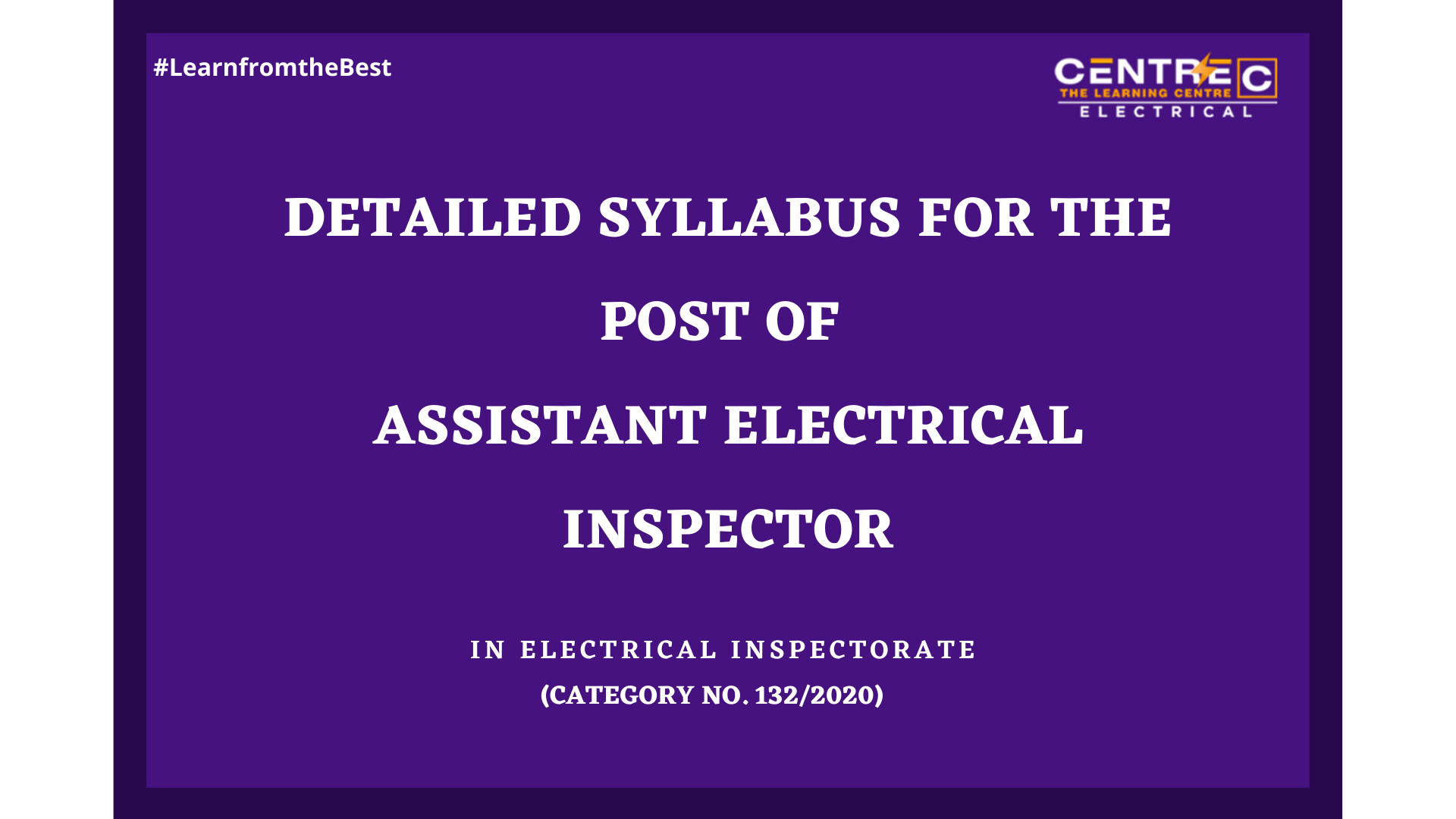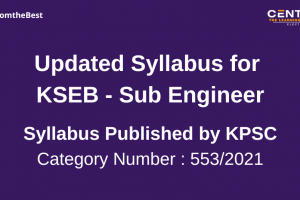
Syllabus: Assistant Electrical Inspector in Kerala Electrical Inspectorate
Detailed Syllabus for Assistant Electrical Inspector in Electrical Inspectorate
(Category No. 132/2020)
Electric Circuits
- Kirchoff’s laws – maximum power transfer theorem. Star/delta transformation. Energy stored in a capacitor and inductor.
- Analysis of coupled circuits – dot polarity convention – sinusoidal steady state analysis of coupled circuits.
- Generation of alternating voltages and currents – rms value, average value, peak factor, form factor.
- AC through series R, L, C circuit – series resonance- resonant power – bandwidth. Resonance in parallel circuits.
Magnetic Circuits- Absolute and relative permeability of a medium
- Magnetic field strength– magnetic potential. Relation between magnetism and electricity – Series and parallel magnetic circuits with composite materials.
- Faraday’s laws of electromagnetic induction– Lenz’s law – statically and dynamically induced emf.
DC Generators
- Constructional details, working principle – types of dc generators – emf equation – power stages – condition for maximum efficiency.
- DC motor – armature control and field control. Single phase transformer – working principle, equivalent circuit, losses in a transformer, condition for maximum efficiency.
- Three phase transformer – construction- difference between power transformer and distribution transformer.
- Alternators– constructional details –Synchronous motor – starting methods – synchronous condenser.
- Three phase induction motor – working principle, constructional details – slip, torque and current equations – torque- speed curve.
Digital Electronics
- Number Systems and Codes: Binary, Octal and hexadecimal conversions- ASCII code, Excess -3 code, Gray code.
- Combinational circuits – Adders – Full adder and half adder. Multiplexers- Demultiplexers. Flipflops – registers – counters. Digital – to – Analogue and Analogue-to-Digital conversion.
- Microprocessors – Internal architecture of 8085 microprocessor–Functional block diagram Instruction set – Addressing modes – Classification of instructions – Status flags. Machine cycles and T states – Fetch and execute cycles- Timing diagram.
Power Systems
- Line parameters -resistance- inductance and capacitance. Insulators –string efficiency corona.
- Circuit breakers – rating- SF6 circuit breaker. Relays – types. Per unit quantities- symmetrical components – symmetrical and unsymmetrical fault.
- Power system stability – steady state, dynamic and transient stability-power angle curve.
Control Systems
- Transfer function of LTI systems – block diagram reduction – Signal flow graph – Mason’s gain formula – Type and Order of the systems-
- Characteristic equation Time domain specifications of transient and steady state responses- Impulse and Step responses of first order and second order systems.
- Static error coefficients of type 0,1,2 systems. Routh’s stability criterion. Frequency domain specifications.
- Polar plot and Bode plot – concepts of gain margin and phase margin- stability analysis.
Power Electronics
- SCR– Structure, Static characteristics. Fully controlled and half controlled bridge rectifier with R, RL and RLE loads.
- Voltage Source Inverters– 1-phase half-bridge & full bridge inverter with R and RL loads – Pulse width modulation. Single quadrant, Two quadrant and Four quadrant chopper.
- Operational Amplifiers – fundamental differential amplifier- Modes of operation. Properties of ideal and practical Op-amp – gain, CMRR and slew rate.
Measurements and Instrumentation
- Measurement standards – errors – Types of Errors. Classification of instruments, secondary instruments–indicating, integrating and recording.
- Ammeters and voltmeters – moving coil, moving iron.
- Measurement of power: Dynamometer type wattmeter –Construction and working – 3- phase power measurement.
- Measurement of energy – Single phase energy meter – construction and working.
- Digital Energy meters -Time of Day(TOD) meters. Oscilloscopes- principle of operation of general purpose CRO-basics of vertical and horizontal deflection system.
Signals and Systems
- Classification of signals – Elementary signals- Basic operations on continuous time and discrete time signals.
- Concept of systems – Classification of systems- Properties of systems – Time invariance- Linearity -Causality – Memory – Stability.
- Sampling process – Impulse train sampling – sampling theorem- Aliasing effect. Zero order and First order hold circuits.
Transducers
- General classification– LVDT- angular displacement transducers- hall effect transducers.
- Batteries – Primary cells– secondary cells- battery ratings- grouping of cells.
- Wiring – systems of wiring- rules for domestic wiring. Earthing- types of earthing – rules for earthing.
- Illumination – Laws of illumination. Electric lamps – different types.
For Complete Syllabus;
CENTRE C ELECTRICAL SOCIAL MEDIA PLATFORMS
Our Social media platforms are exclusively for Electrical Engineering students, job candidates, teachers and all those who have passion for Electrical Engineering.
You will get
- Electrical engineering quiz
- Regular job notifications
- Exam notifications
- E – News
- E – Shots
- Study tips
- Electrical related discussion and all in this group.




